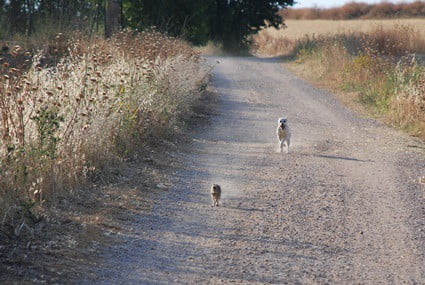(1) Check for any obvious signs of injury
This is especially important if it was your dog who first found and uncovered the babies, as even the friendliest pooches can accidentally harm tiny animals when they get excited! Before you do anything else, take a quick peek at the little ones to make sure that everyone’s okay. Red flags include:
If nothing seems amiss and all of the kits look healthy and content, you can proceed to Step 2. If someone is injured, or one of the babies is actually dead, then skip directly to Step 4.
The good news is that, even if you don’t see the mother rabbit around, the kits are probably not orphaned or abandoned. Mother rabbits tend to leave their babies unattended for long periods of time, only returning a twice a day (at dawn and dusk) to feed, groom, and check up on them. You could have a nest of kits in your backyard for weeks and never once see their mom!
So, unless you’re certain that there’s a problem, the best thing you can do is try to restore the nursery to the way it was before someone disturbed it. Put the babies back (if they’ve been picked up and handled) and try to find the grass/fur drape that originally hid them. Either cover them with that, or—if it’s been destroyed—just shred some dry grass and camouflage the babies as best as you can.
Don’t hang around the any nest longer than you need to. While it’s not true that mother rabbits will reject their babies if humans or dogs leave their scent on them, you run the risk of attracting undue attention to the area. And doing so may encourage animals (especially predators) to come take a look, putting the kits in real danger. Just take care of business and then walk away!
You can, in good conscience, be “done” with the nest at this point, and that’s an easy attitude to have if the nest was in the woods or some kind of public area. But if the nest was in your yard or garden, then you may have a burning desire to continue to see to the kits’ safety and well-being.
Don’t try to monitor the nest 24/7; this will almost certainly do more harm than good. What you can do is take measures to verify that the mother is still checking on the nest as usual. Here are two common tricks:
The following morning or evening, take a quick peek at the nest to see if the floss or baking soda has been disturbed. If it has, then you’ll know that Mama Rabbit came by and everything is fine. If your marks are still pristine, though, then something might be wrong.
Why Do Dogs Kill Baby Rabbits?
Not all dogs have the urge to kill bunnies, but many dog breeds have a strong hunting instinct. A canine’s hunting behavior stems from its time in the wild when dogs needed to hunt and catch their prey to survive. Small mammals, like mice and baby rabbits, which are slower and more vulnerable than larger rabbits, are easy for dogs to kill and eat.
Even though the US National Library of Medicine suggests that dogs were likely the first pet to become domesticated, humans would historically use dogs to sniff out rabbits and displace them from their burrows to control the pest population.
Rabbit hunting is difficult without canine help. They’re small, fast, and hard to catch. Rabbits also live in burrows that go deep into the ground. Humans can’t reach them, but small dogs can – which is why terriers and other small breeds have always been preferred for rabbit hunting.
While pet dogs are now less likely to hunt baby rabbits for food, some dog owners encourage them to pursue bunnies for sport, which means some breeds have retained their hunting instincts. Farmers still use certain dog breeds, like Terriers, Lurchers, and Pointers, for pest control to protect their crops.
If your dog kills a baby rabbit, it’s because its hunting instinct is strong and it’s merely giving in to its natural behavior. While unpleasant and relatively uncommon in pets, it’s quite normal for dogs to eat baby rabbits.
Why Do Dogs Like to Chase Bunnies?
Bunny chasing is motivated by a strong prey drive. Many dog breeds were bred to chase bunnies and other animals that move. A prey animal’s instinctual response is to run, and dogs can’t resist but to give chase.
Chasing is also fun for dogs. It stimulates them both mentally and physically and allows them to release pent up energy. When your dog is in the middle of a chase, it will ignore any calls to stop it because it is so focused on catching its prey.
As small, fast animals, most bunnies can escape a dog’s clutches. But not all dogs will kill the bunny it manages to catch. Some will sniff the animal or encourage it to play. Many dogs will let the rabbit run away because it doesn’t know what to do with it.
However, once a dog has chased a bunny, it is likely to repeat this behavior unless it is encouraged to stop. It may also progress to killing and eating the bunny as it gains more confidence.
